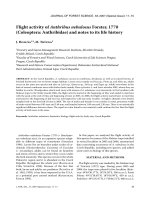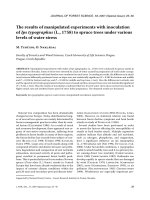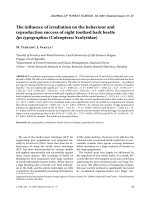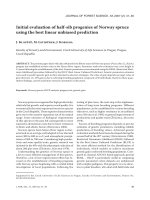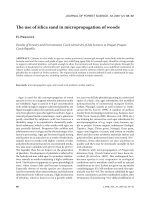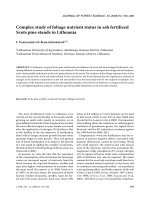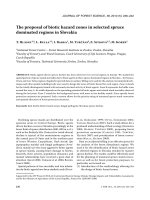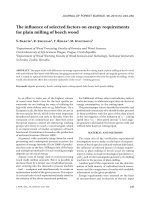Báo cáo lâm nghiệp: "Short-term effects of fire on plant cover and soil conditions in two Austrocedrus chilensis (cypress) forests in Patagonia, Argentina" potx
Bạn đang xem bản rút gọn của tài liệu. Xem và tải ngay bản đầy đủ của tài liệu tại đây (1.98 MB, 9 trang )
63
Ann. For. Sci. 63 (2006) 63–71
© INRA, EDP Sciences, 2006
DOI: 10.1051/forest:2005098
Original article
Short-term effects of fire on plant cover and soil conditions
in two Austrocedrus chilensis (cypress) forests in Patagonia, Argentina
M. Florencia URRETAVIZCAYA
a,b
*, Guillermo E. DEFOSSÉ
a,b
, Héctor E. GONDA
a
a
Centro de Investigación y Extensión Forestal Andino Patagónico (CIEFAP) and Universidad Nacional de la Patagonia,
Ruta 259, km 4, (9200) Esquel, Chubut, Argentina
b
Consejo Nacional de Investigaciones Científicas y Técnicas de Argentina (CONICET), Argentina
(Received 4 October 2004; accepted 5 July 2005)
Abstract – Early post-fire effects on plant cover, in soil temperature (0, 5, 20, and 30 cm depth) and moisture (0–16, 20–36, and 40–56 cm
depth) were analyzed for two years in two cypress stands in Patagonia, Argentina. Each stand (Trevelin = xeric and Bolsón = mesic) contained
three treatments: unburned (UN), partially (PB), and completely burned (CB). In Trevelin, 4 and 6 years after fire, understory cover increased
(CB > PB > UN) and overstory decreased (CB = PB < UN) related to the burning treatment. In Bolsón, one year after fire, all treatments had
similar under- and overstory cover, but were similar to Trevelin two years later. Soil temperature was significantly different (PB > CB > UN)
at all depths and dates only in Trevelin. Soil moisture was significantly higher in the burned treatments of both stands. While plant cover might
have protective effects and soil water appears as not limiting, high soil temperatures seem to be detrimental for post-fire cypress establishment,
especially in xeric sites.
Austrocedrus / fire / soil temperature-moisture / southern temperate forest / establishment
Résumé – Les effets du feu à court terme sur la couverture végétale et sur les conditions du sol dans deux forêts d’Austrocedrus chilensis
(cyprès) en Patagonie, Argentine. On analyse ici les effets du feu à court terme sur la couverture végétale, la température (0, 5, 20, et 30 cm
de profondeur) et l’humidité du sol (0–16, 20–36, et 40–56 cm de profondeur) dans deux peuplements de cyprès en Patagonie, Argentine, au
long de deux années. Les peuplements (Trevelin = xérique; Bolsón = méssique) présentent trois traitements : non-brûlé (UN), partiellement
brûlé (PB) et totalement brûlé (CB). À Trevelin, 4 et 6 ans après le feu, la couverture du sous-bois inférieur augmenta (CB > PB > UN) tandis
que celle du sous-bois supérieur diminua (CB = PB < UN) dépendant du traitement de brûlage. À Bolsón, un an après le feu, la couverture des
deux étages du sous-bois fut la même pour les trois traitements, quoique deux ans plus tard la situation se rapprocha de celle de Trevelin. Seule
à cet endroit, la température du sol montra des différences significatives (PB > CB > UN) à chaque profondeur et à chaque date. Dans les deux
peuplements, l’humidité du sol a été nettement plus haute pour les traitements brûlés. Tandis que la couverture végétale pourrait avoir des effets
de protection et que l’humidité du sol n’apparaît pas comme étant limitative, les hautes températures du sol semblent être restrictives pour
l’établissement des cyprès à la suite du feu, notamment dans les sites xériques.
Austrocedrus / feu / température / humidité du sol / forets tempérées / établissement
1. INTRODUCTION
One of the main effects of fire on forest communities is the
opening of gaps of various sizes in which the normal radiation
regime is altered, producing substantial differences in micro-
climate between newly burned and unburned canopy-covered
areas [7]. In burned areas, soil surface is affected by both, the
immediate and direct effect of heat caused by the actual fire,
and by the additional and long-lasting effects of absorbed radi-
ation received by the blackened surface after the fire has passed.
Apart from the damage caused to aboveground biomass, fire
can alter same properties of the soil, mainly due to the rapid
combustion of the organic matter located on its surface [1, 11].
If the organic horizon is consumed, the exposed mineral soil
may increase its temperature for months, or even years, due to
the direct radiation received [33, 35]. The subsequent changes
in soil temperature and other soil properties caused by fire will
certainly influence post-fire community succession, and may
affect nutrient cycling, water relations, microbial community
structure, and seedling establishment [11, 12, 35].
In northwestern Patagonia the Austrocedrus chilensis
(D. Don) Pic. Ser. et Bizzarri forests (locally called cypress)
occupy 140 000 ha. Stands occur along a narrow strip between
37° 08' 09'' and 43º 43' 57'' S and 71º 49' 18'' and 70º 30' 29'' W
[6]. This 50 km wide strip of forest comprises one of the most
extreme west-east precipitation gradients in the world [50].
Cypress is a long-lived species [29] and forms dense, mixed
stands with Nothofagus dombeyi (Mirb.) Oerst. (locally called
* Corresponding author:
Article published by EDP Sciences and available at or />64 M.F. Urretavizcaya et al.
coihue) in humid sites, pure stands on drier sites, and open
stands on xeric sites near the ecotone between the forest and
the Patagonian steppe. Fire is the main disturbance associated
to the dynamics of cypress forests [49].
In these forests, the natural fire regime varies according to
the precipitation regime. In general, fire frequency increases
from the humid sites in the west, towards the xeric sites in the
east [22]. In the past, fire frequency increased in the majority
of cypress stands after 1850, coincidentally with an increase in
number of indigenous people that inhabited the region and the
beginning of European settlement. This frequency peaked at
the end of the
XIXth century, and started to decline from then
on because indigenous population decreased, and the creation
of several National Parks in the region brought about the policy
of fire suppression [48].
Intense fires produce severe cypress damage and mortality,
since this species has a very thin bark and is unable to sprout
[49]. After a fire event, however, cypress establishment seems
to be influenced by site conditions, being rapid in humid and
mesic sites and slower in xeric areas [24, 49]. Since this species
reproduces almost exclusively by seed, regeneration is condi-
tioned by the chance of seeds to find “safe sites” (sensu Harper
[18]) where they can successfully germinate and become estab-
lished. This series of events depends on the availability of ger-
minable seeds, restrained by the distance to the mother tree
because of its low dispersal capacity [14, 49], and a transient
seed bank [47], the occurrence of favorable weather periods
[51], and the presence of a propitious soil microsite. In
unburned vegetation, the protection provided by understory
vegetation seems to benefit cypress stand recruitment [16, 44].
During the last decade, fires affected 77 000 ha of native for-
ests in the Provinces of Río Negro and Chubut [38, 46]. Within
these provinces, cypress forest were the most affected after Not-
hofagus antarctica (Forst. F.) Oerst. (locally called ñire) for-
ests. In general, fires are of anthropogenic origin (accidental
and/or intentional), being less frequent those produced by nat-
ural causes [13]. The possibility of occurrence of big, intense
fires has increased because the reduction in fire frequency
caused by the suppression policy implemented in the
XXth cen-
tury allowed the accumulation and continuity of fine fuels [23].
Some studies have dealt with the dynamics of cypress stands
at different time-span periods after fire events [15, 17, 22, 51].
However, little emphasis has been placed on the importance
that microenvironmental and biotic conditions achieved in the
first successional stages after the fire, especially plant cover and
soil temperature and soil moisture, may play in seedling
dynamics. The occurrence of dry periods, high temperatures
and scarce water availability during the growing seasons are
known as limiting factors for the establishment, survival and
growth of several forest species [26] similar to what might hap-
pen with cypress. The objectives of this study were to charac-
terize: (a) the temporal changes in plant cover in cypress stands
completely burned, partially burned and unaffected by fire
(unburned); (b) the seasonal dynamics of temperature and
moisture at various soil depths in these burned and adjacent
unburned areas, and (c) how changes in plant cover and tem-
perature and moisture in the soil caused by fire may affect
cypress seedlings establishment.
2. MATERIALS AND METHODS
2.1. Study area
A similar study was carried out during the years 2000 to 2002 in
two pure cypress stands located 220 km apart within the southern por-
tion of the distribution area of cypress in Patagonia. The first stand,
called Trevelin (43° 12' 57'' S, 71° 31' 15'' W), located close to the city
of Trevelin in Chubut province, had been burnt in December 1996. The
second study, referred to as Bolsón, was located in the Loma del
Medio-Río Azul Forest Reserve (41° 59' 02'' S, 71° 33' 20'' W), in the
outskirts of El Bolsón town, in Río Negro province, and had been burnt
in January 1999. The unburned portion of the Trevelin stand was 44.2
years old (± 6.7) and had 958 cypress ha
–1
, with a dominant height of
13 m, and a quadratic mean diameter (QMD) of 18.7 cm. The unburned
fraction of the Bolsón stand was 81.4 years old (± 6.2) and had 864
cypress ha
–1
, with a dominant height of 18 m, and had a QMD of
20.7 cm. Soil parent material was volcanic ash on both study sites [8,
9]. While the Trevelin stand presented a glacifluvial lithological dis-
continuity [28] and an A horizon with silty-clay texture, the Bolsón
stand showed a very deep soil and an A horizon with loamy texture.
The climate in both study sites is temperate, with 75% of the annual
precipitation falling between April and September (late fall and winter
in the Southern Hemisphere). Spring and summer are generally warm
and dry [10]. Mean annual temperature and precipitation are 8.2 ºC
and 684 mm in Trevelin [3] and 9.9 ºC and 921 mm in Bolsón [7].
Trevelin could be considered a xeric site while Bolsón would be mesic.
Precipitation fallen during the first growing season considered in this
study (2000–2001) was 187% and 156% higher than mean climatic values
registered for Trevelin and Bolsón, respectively, while for the second
growing season (2001–2002), by contrast, these values diminished to
49% and 60% for each site, respectively. Taking these values into con-
sideration and according to other authors [24, 31], the first growing
season was considered in this study as humid, while the second as very
dry.
2.2. Stands selection and sampling procedure
Within each stand, an area was identified in a way that, containing
the fire line, presented similar characteristics related to local condi-
tions such as slope and exposure as well as similarities in stand struc-
ture before the fire took place. The size of the study area was 144 m
by 44 m in Trevelin stand and 128 m by 64 m in Bolsón stand. Each
study area included three contiguous but different levels of fire dis-
turbance: Unburned (UN): a sampling area upon which no cypress
trees or its understory had been affected by the fire; Partially Burned
(PB): sampling area had been affected by fire, burning its understory
and overstory, but contained living cypress trees; and Completely
Burned (CB): in which the understory and overstory of the sampling
area had been affected by fire, and presented no surviving cypress trees
around them. Each level of fire disturbance was considered to be the
treatments in each study. The Trevelin study area was fenced to pre-
vent grazing by large herbivores (mainly cattle) but this was not nec-
essary at the Bolsón study area. Fifteen 40 m
2
circular plots were
randomly established within each study area. These plots were the
sampling units in which the different response variables were mea-
sured. Since the resulting number of plots per treatment was uneven,
we used an unbalanced experimental design.
2.3. Plant cover
Understory and overstory cover was assessed separately by sub-
sampling each sampling unit. In the case of understory cover, five cir-
cular subplots 2.4 m in diameter were established in each sampling
unit. One subplot was located at the center of the sampling unit, while
Postfire conditions in Austrocedrus forests 65
the other four were equidistant from one another. Understory cover
was determined by visually estimating the percentage of soil surface
covered by plants in each subplot, dividing it into four quadrants to
simplify the procedure. A mean value per sampling unit was obtained.
In each sampling unit, overstory cover was determined in the center
of the five subplots established to measure understory cover. Over-
story cover was measured at 1.30 m aboveground with a Spherical
Densiometer Model A. At each point, four readings were recorded,
each one facing to a cardinal point, according to the technique pro-
posed by Lemmon [30]. This cover, thus, included live and dead trees
as well as shrubs at least 1.5 m tall.
At the beginning of the study, cypress regeneration was determined
by counting the seedlings of this species that were smaller than 5 cm
of diameter at breast height (DBH). Four categories were differenti-
ated in relation to the size of regeneration. Plants whose height was
below 20 cm were considered as belonging to category 0; those from
20 to 50 cm in height to category I; from 50 to 130 cm in height to
category II; and those whose height was above 130 cm but their DBH
was below 5 cm, to category III. Cypress seedlings belonging to cat-
egory 0 were counted in 18 m
2
concentric plots within each 40 m
2
plots
on which the other categories were counted.
2.4. Soil temperature and moisture
Soil temperature was measured at four different depths on several
points (subsamples) within each sampling unit. Soil temperature at
depths 0 and 5 cm (ST-0 and ST-5) was measured on five points in
each sampling unit, on the same points where overstory cover was
determined. Temperature at depths 20 and 30 cm (ST-20 and ST-30)
was measured only in two points, randomly selected among those five
due to smaller variation associated with soil depth. Temperature at all
depths was measured from September 2000 to April 2002, every 20 days
during spring and summer and every three months during fall and win-
ter. Temperature at the soil surface was measured between 14:00 and
14:30 h, and ST-5, ST-20, and ST-30 between 14:00 and 17:00 h. Sur-
face temperature was measured with a laser thermometer (Cole Parmer
SM 39650-02), and ST-5, ST-20 and ST-30 with thermocouple ther-
mometers (Cole Parmer Digi-Sense
Model NO 91100-50).
Soil moisture of three different soil layers, 0 to 16 cm (SM-0), 20
to 36 cm (SM-20), and 40 to 56 cm (SM-40), was measured at several
points (sub-samples) within each sampling unit. SM-0 was measured
on five points in each sampling unit in the same points where ST-0
and ST-5 were determined; SM-20 and SM-40 were measured in one
point on the edge of the sampling unit. From September 2000 to April
2002 SM-0 was measured at the same time intervals as temperatures.
Soil moisture in the other two layers (SM-20 and SM-40) was meas-
ured in April and October 2001, and in January and April 2002, each
time in a different location along the edge of the sample unit. SM-0
was determined between 10:00 and 12:00 h and in SM-20 and SM-40
between 14:00 and 17:00 h. Soil moisture was measured with a TDR
IMKO Trime FM-3 hand-held moisture meter with P3 sensors 16 cm
long.
2.5. Design and analyses
On both study sites, the effects of the treatments on understory and
overstory were analyzed separately for each year with ANOVA tech-
niques. The same technique was used to analyze cypress regeneration.
Multiple comparison of means to test significant differences among
treatments were analyzed with Tukey-Kramer test. This test is a mod-
ification of Tukey test for unbalanced designs [45]. The effects of the
treatments on temperature and moisture at different soil depths
through time were analyzed with repeated measures analysis of vari-
ance [53] because measurements were taken on the same experimental
unit. In this case where the tests involve only between-subjects effects,
both multivariate and univariate approaches give rise to the same test
[45]. The Tukey-Kramer test was used to determine significant differ-
ences among these variables.
3. RESULTS
3.1. Plant cover
In Trevelin, the effects of the fire treatments on plant cover
showed a similar pattern four (2000) and six (2002) years after
fire (Figs. 1a and 1b). Understory cover increased in direct rela-
tion to the degree of burning (CB > PB > UN), and the differ-
ences among treatments were significant (p < 0.01). The
percentage of cover was about 80%, 40% and 10% in CB, PB,
and UN treatments, respectively, for both years (Fig. 1a). Over-
story cover, by contrast, showed an inverse pattern (UN > PB >
CB), being significantly higher (p < 0.01) in the UN (60%) as
compared to PB (25%) and CB (20%) (Fig. 1b). The presence
of cypress regeneration of all sizes was absent in CB, and in
all but in Category II in PB. All these values were significantly
lower (p < 0.05) with respect to UN (Tab. I). No further seed-
ling establishment was observed during the rest of the study
period.
In Bolsón, results in the year 2000 were different from those
obtained in the year 2002. In 2000, both covers (Figs. 1c and
1d) were not significantly different in all plots regardless the
degree of burning. By contrast, in 2002, understory cover
increased (p < 0.01) in direct relation to the degree of burning
(CB > PB > UN), while overstory cover decreased (p < 0.01)
in the PB and CB treatments related to UN. In this site, cypress
regeneration was absent for CB, while it took intermediate val-
ues for PB as compared to CB and UN (Tab. I). The individuals
counted in PB are those which survived the fire event.
3.2. Soil temperature
In Trevelin, soil temperature in the PB and CB treatments
was significantly higher (p < 0.01) than in UN at all soil depths
and during the whole study period (Figs. 2a to 2d), these dif-
ferences being of higher magnitude during the growing season.
In these seasons, in PB treatment, ST-0 and ST-5 reached 57 ºC
and 31 ºC, respectively. In the CB treatment, ST-0 and ST-5
reached 49 ºC and 29 ºC, while in UN, never exceeded 42 ºC
and 22 ºC, respectively. In Trevelin, ST-0 recorded in the UN
treatment exceeded 40 ºC only once during the first summer,
while in PB and CB, ST-0 remained above 40 ºC for three and
two months, respectively (Fig. 2a). Below soil surface, ST-5
went above 20 ºC only once (in February of 2002) for the UN,
while for PB and CB these temperatures remained above 20 °C
for about five months for the first year and for four months for
the second year, respectively. Deeper into the soil, the pattern
of ST-20 and ST-30 was similar to that described for ST-0 and
ST-5, although temperatures were of lower values.
In Bolsón, by contrast, soil temperature during the study
period was similar in the three treatments at all depths (Figs. 2e
to 2 h). One year after the fire event, ST-0 reached 37 ºC and
42 ºC in the PB and CB treatments, and 44 ºC in the UN. On
the second growing season, ST-0 never exceeded 39 ºC in the
66 M.F. Urretavizcaya et al.
UN, but reached peaks of 55 ºC and 40 ºC on PB and CB, respec-
tively. Although ST-5 showed no significant differences
among treatments during the whole study period, it did show
significant differences (p ≤ 0.01) between CB and UN during
the spring of the first growing season (2000, Fig. 2f). These
differences, of about 4 ºC, occurred concomitantly with the
higher ST-0 registered the first growing season after the fire
event (2000–2001).
Figure 1. Mean percentage (± one standard error) of understory (a, c) and overstory cover (b, d) for Trevelin and Bolsón, measured in 2000
and 2002. Lower case letters above bars indicate significant differences at (p < 0.05) among treatments.
Tab le I. Cypress regeneration, expressed as individuals ha
–1
(± one standard error) per treatment in both study areas. Treatments showing dif-
ferent letters indicate significant differences at p < 0.05 for every category and within each study area.
Trevelin Bolsón
Regeneration UN PB CB UN PB CB
Cat. 0: < 20 cm height 1 759.2 a
(± 804.0)
0 b 0 b 56 983.6 a
(± 21 333.3)
3 888.8 ab
(± 3 333.3)
0 b
Cat. I: > 20 cm and < 50 cm height 3 291.6 a
(± 2 293.4)
0 b 0 b 1.041 7 a
(± 553.1)
125.0 ab
(± 125.0)
0 b
Cat. II: > 50 cm and < 130 cm height 2 666.6 a
(± 1 333.3)
83.3 b
(± 83.3)
0 b 666.7 a
(± 368.9)
0 b 0 b
Cat. III: > 130 cm height and < a 5 cm DBH 2 791.6 a
(± 820.1)
0 b 0 b 978.3 a
(± 430.2)
250.0 ab
(± 250.0)
0 b
Postfire conditions in Austrocedrus forests 67
Figure 2. Soil temperature (average ± one standard error) at different depths measured during September 2000 and April 2002 in Trevelin and
Bolsón, respectively. ST-0, ST-5, ST-20, and ST-30, represent soil temperatures at 0, 5, 20 and 30 cm in depth respectively. Shaded areas repre-
sent the growing seasons.
68 M.F. Urretavizcaya et al.
3.3. Soil moisture
In Trevelin, soil moisture showed significantly higher dif-
ferences (p ≤ 0.01) among depths and treatments. Considering
the whole study period, SM-0 and SM-20 were higher on PB
and CB in relation to UN, while SM-40 was higher only in CB
(Figs. 3a to 3c). Although the pattern of variation in SM-0 was
similar for all three treatments, the range of values was differ-
ent. For example in CB treatment, SM-0 reached values higher
than 50% during spring of the first growing season and up to
the following winter, descending to 11% during the next season
(very dry). In the UN, by contrast, SM-0 never exceeded 28%,
descending to 5% during the very dry season. Absolute differ-
ences in SM-0 between CB and UN were always higher than
4% (Fig. 3a). In all three treatments, SM-20 and SM-40 also
showed a similar pattern of variation. At these two depths, soil
moisture in CB varied between 17% and 32%, while in UN var-
ied between 8% and 24%. The CB treatment always showed
soil moisture content that was, in average, 9% higher as com-
pared to UN, except in April 2002, when it was only 6% higher.
In Bolsón and during the whole study period, SM-0 and SM-
20 were significantly higher (p < 0.05) in treatments CB and
PB as compared to UN, while SM-40 was significantly higher
(p < 0.05) in CB as compared to UN (Figs. 3d to 3g). In this
site, maximum values in SM-0 differed among treatments for
the first season (46% in CB and PB, 39% in UN), while for the
second season (very dry) the minimum value was similar for
the three treatments (Fig. 3d). The pattern of soil moisture var-
iation was similar at SM-20 and SM-40 for all three treatments
but, as reported for Trevelin, CB was the treatment that pre-
sented the highest moisture values, and UN, the lowest. Mois-
ture variation ranged from 17% to 42% for CB, while it was
7% to 33% for UN.
Figure 3. Soil moisture (average ± one standard error) at different depths measured during September 2000 and April 2002 in Trevelin and
Bolsón, respectively. SM-0, SM-20, y SM-40 represent soil moisture between 0 and 16 cm, 20 and 36 cm, and 40 and 56 cm in depth respectively.
Shaded areas represent the growing seasons.
Postfire conditions in Austrocedrus forests 69
4. DISCUSSION
4.1. Plant cover
In Trevelin, understory and overstory cover had not varied
too much between the fourth (2000) and the sixth (2002) year
after the fire had taken place, because four years after the fire
event, most of the remaining snags had already fallen and the
herbs had had the chance to spread along the partially and com-
pletely burned areas. In Bolsón, by contrast, one year after the
fire (2000), burned trees were still standing, and the herbaceous
species just started to establish. Similar results were reported
for Pinus halepensis Mill. Forests in the Iberian Peninsula,
where eight months after the fire, the herbaceous strata did not
show any association with the severity classes considered [39].
In Bolsón three years after the fire, understory vegetation had
already colonized the burned areas, and plant cover showed a
similar pattern as the one observed in Trevelin. Similar pattern
of herbage recovery, decrease of bare soil areas and lack of
regeneration 15 years after a fire were reported by Gobbi and
Sancholuz [17] for another cypress forest. The understory and
overstory observed in both sites at the end of the study period
does not appear as a limiting factor that would deleteriously
affect early cypress seedling establishment. This consideration
is based upon the results reported by other studies, which dem-
onstrated the positive relationship that exist among herbaceous
and shrub cover and cypress seedling establishment [16, 24, 44].
4.2. Soil temperature
The high soil temperatures recorded for the burning treat-
ments (PB and CB) in Trevelin, significantly higher than those
of UN treatment, can potentially limit cypress establishment
since growth of woody plants seedlings at the cotyledon stage
of development are particularity sensitive to temperature
extremes [26, 27]. The combination of above-normal and long
lasting soil and ambient temperatures can cause injury to roots
and stems, inhibiting the growth and eventually led to death to
seedling shoots [25–27, 55].
It has been well established that high temperatures at the soil
surface are correlated with low seedling survival in a variety
of plant species in many environments [32], including boreal
and cold-temperate forests [25]. Optimum soil temperature for
root growth of many woody plants of temperate zones is
between 20–25 ºC [27]. In Trevelin ST-5 in the UN treatment
was always lower than 20 ºC, except during the second growing
season, when it reached to 22 ºC. By contrast, temperatures in
PB and CB were, in average, 7 ºC higher than in UN during the
growing seasons studied. Considering that small deviation in
optimum temperatures can affect root growth in several plant
species [34], it would be possible that they may affect cypress
seedling roots in the same way.
In other temperate forests, when comparing burned with
unburned areas, maximum soil temperatures could reach sim-
ilar values, but in unburned areas these temperatures tend to be
of short duration, lasting only for a few days [2]. In the cypress
forest stand of Trevelin, the UN treatment registered high tem-
peratures only once, while in burned treatments these high tem-
peratures remained for more than two months in ST-0, and for
more than five months in the case of ST-5. Deeper into the soil,
although with lower values, the pattern of soil temperature was
similar as the one reported for the upper soil. These high tem-
peratures might severely damage cypress seedlings by over-
heating and dehydration, as has been reported for other species
[27]. The rates of extension and root mortality could also be
affected if soil temperature reach values that are above the opti-
mum for root growth [40].
In Trevelin, the partially burned areas (PB) showed higher
variation in soil temperature as compared to completely burned
(CB) areas. This apparently contradictory finding, could be
explained by taking into consideration that treatment CB
showed a understory cover more evenly distributed than PB,
acting this vegetation a barrier that impeded the direct radiation
to reach the ground as may have happened in other sites [27,
54]. Another aspect associated to changes in soil temperature
found in these two treatments could be related to the settlement
of the treatments themselves. Although the treatments were
carefully set, it was unavoidable that small local variations
present prior to the fire could have altered (increasing or
decreasing), the subsequent effects of fire [5]. The classifica-
tion of the severity of a fire based only on function of the
remaining surviving trees could be then insufficient to classify
that event with certain degree of accuracy ([39] and references
herein). As pointed out by Robberecht et al. [43] and Robberecht
and Defossé [42], more quantitative data about the actual fire
and its effects should be necessary to characterize a fire event and
its severity. In Trevelin, our PB treatment, then, should be con-
sidered only as a relative measure of fire intensity and severity
in between the UN and CB treatments.
As mentioned above, soil temperature is generally altered
after a forest fire, particularly at the soil surface [1]. In Bolsón,
however, we found no significant differences in soil tempera-
tures among treatments. Apart from the fact that Bolsón was
considered as a mesic site, as compared to Trevelin (xeric), the
lack of differences found in soil temperatures among treatments
could have been due, in part, to the weather conditions prevail-
ing during the first summer after the fire, which were wetter and
cooler than normal. It is well known that due to the latent heat
of water, more energy is needed to increase the temperature of
a wet soil than one similar that remain dry [21, 34, 41]. In Bolsón,
both fire disturbed treatments (PB and CB) had higher soil
moisture from mid-spring to end of summer than that of the UN
treatment (see Fig. 3), and this may have lessened differences
in temperature. During the second growing season, although
the weather conditions were relatively hot and dry as compared
to the long-term mean, the understory cover, by then fully
recovered, could have acted as a barrier, in a similar way as it
was reported for Trevelin and for other ecosystems [27, 54].
Similarly to what was observed in Trevelin and Bolsón, soils
in burned areas of mixed oak forests in Ohio, USA, were
warmer than those of the nearby unburned forest, and within
them, xeric areas were warmer as compared to mesic. Soils in
burned xeric sites showed from 3.5 ºC to 5.7 ºC higher than
unburned soils, while these differences were of 0.5 ºC to 0.6 ºC
for mesic sites [19]. This pattern was attributed, in part, to the
combined effects of higher water content and its thermodynam-
ics and the reduced exposure to direct solar radiation of soils
of mesic areas as compared to those of xeric areas [20].
70 M.F. Urretavizcaya et al.
4.3. Soil moisture
Fire effects upon soil moisture are indirect and not fre-
quently well defined [41], since they depend on different fac-
tors such as the amount of Organic Matter consumed [52], soil
drainage characteristics [36] and the temperatures reached by
the soil at the time of fire and after it [56]. In Trevelin, burned
treatments (PB and CB) showed higher soil water content at all
depths as compared to the unburned treatment (UN) during the
whole study period. This condition was independent from the
growing season considered, since the first growing season was
markedly moist and the second very dry. In Bolsón, the pattern
of soil moisture was similar to that of Trevelin, and burned
treatments (PB and CB) showed higher soil water content at all
depths and seasons, the exception being surface soil moisture
at the end of the dry season, which was similar for all treatments
considered. Soil moisture condition found in burned areas in
both study sites, does not appear to be a limiting factor for
cypress establishment, since it never was lower than that of
unburned areas. The increase in soil moisture content in burned
areas as compared to unburned is consistent with the reduction
in the amount of vegetation, which may result in lower eva-
potranspiration rates and low precipitation interception, similar
to what Kimmins [21] and O’Neill et al. [36] reported.
4.4. Conditions for cypress establishment
in burned areas
In the relatively short time after a fire (from one to six years)
there are significant changes in understory and overstory, and
in the patterns of soil temperature and moisture in burned
cypress forests of Patagonia. Once fire disturbance occurs, the
duration and magnitude of post-fire changes for stand recovery
seemed to be directly related to the environmental conditions
prevailing at the time of the fire, after it, and to the specific con-
ditions of the site considered. In burned areas, the consumption
of biomass and reduction of vegetation cover by the actual fire
increased soil temperatures that may persist for several years,
being this effect magnified in xeric areas as compared to mesic.
Soil moisture, by contrast, appeared as a non limiting factor in
either site, since burned plots had always higher water content
at all depths than unburned ones.
Burned areas showed also significantly less germinable
seeds than unburned areas [47], adding another factor that may
reduce the availability of “safe sites” for successful seedling
germination and establishment. This synergistic effect (lower
seed availability and higher soil temperatures) appear to be
magnified in the more xeric site (i.e. Trevelin). In contrast, at
Bolsón site (a more humid site and with least extreme soil tem-
perature values), this effect seems to be lessened, particularly
in the first few years after the fire. Similar to what happens with
cypress, in species such as Picea glauca, regeneration in the
first years after the fire would depend on the presence of prop-
agules and of the characteristics of the seed bed [4].
High and persistent soil temperatures in xeric areas may help
explain why, apart from the fact that cypress has a transient soil
seed bank and that its size is greatly influenced by the degree
of fire disturbance [47], burned cypress forests recover faster
in mesic or humid areas, as compared to xeric sites. Our results
thus coincidence with what was reported by Veblen et al. [49],
Villalba and Veblen [51] and Kitzberger et al. [24], who pointed
out that cypress seedling establishment in xeric sites is greatly
influenced by environmental conditions. In general and for
both sites, it seems that after a fire event, the colonization of
burned areas by pioneer herbs and shrubs could be a mechanism
to avoid high temperatures extremes, that otherwise could over-
heat and dehydrate cypress seedlings. This protective effect
against unfavourable microenvironmental conditions could
prevail over that of competition, providing thus a safe site for
successful establishment. In xeric sites, where cypress germi-
nation, growth and establishment is more sporadic and mar-
ginal, appropriate restoration practices could speed up
successful post-fire establishment.
Acknowledgements: The authors wish to acknowledge Luciano
Taladriz, Marcelo Rey, Ivor Roberts, Diego Truco, Cecilia Ciámpoli,
Wessel de Meijere, Alejandro Martínez Meyer, Fernando Coronato
and Mario Rajchenberg for their help in many stages of this study. This
research was supported by the International Foundation for Science,
Stockholm, Sweden (Grant No. D/3120/1), and by an assistantship
from the Consejo Nacional de Investigaciones Científicas y Técnicas
de Argentina (CONICET) to M. F. Urretavizcaya.
REFERENCES
[1] Agee J.K., Fire Ecology on Pacific Northwest, Island Press, Wash-
ington, D.C., 1993.
[2] Ahlgren C.E., Effects of fires on temperate forest: North Central
United States, in: Kozlowski T., Ahlgren C.E. (Eds.), Fire and Eco-
systems, Academic Press, New York, 1974, pp. 195–224.
[3] Albuinés M.R., Relevamiento y estudio del régimen climático de la
provincia del Chubut, Informe de plan de trabajo Nº 1020, INTA
EEA Trelew, Chubut, Argentina, 1998.
[4] Awada T., Henebry G.M., Redmann R.E., Sulistiyowati H., Picea
glauca dynamics and spatial pattern of seedlings regeneration along
a chronosequence in the mixedwood section of the boreal forest,
Ann. For. Sci. 61 (2004) 789–794.
[5] Bock C., Bock J., Shrub densities in relation to fire, livestock graz-
ing, and precipitation in Arizona desert grassland, Southwest Nat.
42 (1997) 188–193.
[6] Bran D., Pérez A., Barrios D., Pastorino M., Ayesa J., Eco-región
valdiviana: distribución actual de los bosques de “ciprés de la cor-
dillera” (Austrocedrus chilensis) – Escala 1:250.000, INTA-APN-
FVSA, Bariloche, Argentina, 2002.
[7] Bustos J.C., Rocchi V.C., Caracterización termopluviométrica de
veinte estaciones meteorológicas de Río Negro y Neuquén, Informe
Técnico INTA EEA Bariloche, Río Negro, Argentina, 1993.
[8] Collmet Dâage F., Lanciotti M.L., Marcolin A.A., Importancia
forestal de los suelos volcánicos de la Patagonia Norte y Central:
Climo-topo-secuencia de suelos y vegetación, INTA EEA Barilo-
che, Argentina, 1995.
[9] Collmet Dâage F., Mazzarino M.J., Lanciotti A.A., Características
de los suelos volcánicos en el S.O. del Chubut, Comunicación Téc-
nica Nº 22, Recursos Naturales-Suelos, INTA EEA Bariloche,
Argentina, 1993.
[10] De Fina A.L., El clima de la región de los bosques Andino-Patagó-
nicos Argentinos, in: Dimitri M.J. (Ed.), La Región de los Bosques
Andino-Patagónicos Sinopsis General, Colección Científica del
INTA, Buenos Aires, Argentina, 1972, pp. 35–58.
[11] DeBano L.F., The effect of fire on soil properties. Symposium on
Management and Productivity of Western-Montane Forest Soil,
Boise, ID, April 10–12, 1990.
[12] DeBano L.F., The role of fire and soil heating on water repellency
in wildland environments: a review, J. Hydrol. 231–232 (2000)
195–206.
Postfire conditions in Austrocedrus forests 71
[13] DGByP, Estadísticas de incendios y análisis de causas, Informe
Técnico Dirección General de Bosques y Parques de la Provincia
del Chubut, Argentina, 1999.
[14] Gobbi M., Condiciones para la regeneración natural del ciprés de la
cordillera (Austrocedrus chilensis) en áreas incendiadas, II Con-
greso Latinoamericano de Ecología, Brasil, 1992.
[15] Gobbi M., Regeneración de la vegetación en incendios recientes de
bosques de “ciprés de la cordillera” (Austrocedrus chilensis) en el
área del Parque Nacional Nahuel Huapi, Medio Ambiente 12
(1994) 9–15.
[16] Gobbi M., Austrocedrus chilensis management: effects on microsi-
tes and regeneration, Int. J. Ecol. Environ. Sci. 25 (1999) 71–83.
[17] Gobbi M., Sancholuz L., Regeneración post-incendio del “ciprés de
la cordillera” (Austrocedrus chilensis) en los primeros años, Bos-
que 13 (1992) 25–32.
[18] Harper J.L., Population Biology of Plants, Academic Press, London,
1977.
[19] Iverson L.R., Hutchinson T.F., Soil temperature and moisture fluc-
tuations during and after prescribed fire in mixed-oak forest, USA,
Natural Areas J. 22 (2002) 296–304.
[20] Iverson L.R., Prasad A.M., Hutchinson T.D., Rebbeck J., Yaussy
D.A., Fire and thinning in an Ohio oak forest: grid-based analyses
of fire behavior, environmental conditions, and tree regeneration
across a topographic moisture gradient, in: Spetich M.A. (Ed.),
Upland oak ecology symposium: history, current conditions, and
sustainability, Gen. Tech. Rep. SRS-73, Asheville, NC, USDA,
Forest Service, SRS, 2004.
[21] Kimmins J.P., Forest Ecology: A Foundation for Sustainable
Management, Prentice Hall, Upper Saddle River, New Jersey,
1997.
[22] Kitzberger T., Fire regime variation along a northern Patagonian
forest-steppe-ecotone: stand and landscape response, Ph.D. thesis,
Department of Geography, University of Colorado, Boulder, Colo-
rado, 1994.
[23] Kitzberger T., Veblen T.T., Fire-induced changes in northern Pata-
gonian landscapes, Landscape Ecol. 14 (1999) 1–15.
[24] Kitzberger T., Steinaker D.F., Veblen T.T., Effects of climatic
variability on facilitation of tree establishment in northern Patago-
nia, Ecol. 81 (2000) 1914–1924.
[25] Kolb P.F., Robberecht R., High temperature and drought stress
effects on survival of Pinus ponderosa seedlings, Tree Physiol. 16
(1996) 665–672.
[26] Kozlowski T.T., Pallardy S.G., Acclimatation and adaptative res-
ponses of woody plants to environmental stresses, Bot. Rev. 68
(2002) 270–334.
[27] Kozlowski T.T., Kramer P.J., Pallardy S.G., The physiological eco-
logy of woody plants, Academic Press, San Diego, 1991.
[28] La Manna L., Caracterización de los suelos bajo bosques de Austro-
cedrus chilensis a través de un gradiente climático y topográfico en
Chubut, Argentina, Bosque 26 (2005) 137–153.
[29] LaMarche V.C., Holmes R.L., Dunwiddie P.W., Drew L.G., Tree-
ring chronologies of the Southern Hemisphere, Argentina, Chrono-
logy Series V, Laboratory of Tree-ring Research, University of Ari-
zona, Tucson, 1979.
[30] Lemmon P.E., A spherical densiometer for estimating forest over-
story density, For. Sci. 1 (1956) 314–320.
[31] Letourneau F.J., Andenmatten E., Schlichter T., Effect of climatic
conditions and tree size on Austrocedrus chilensis-shrub interac-
tions in northern Patagonia, For. Ecol. Manage. 191 (2004) 29–38.
[32] Levitt J., Responses of plants to environmental stresses, Academic
Press, New York, 1980.
[33] Macadam A., Effects of prescribed fire on forest soils, BC Ministry
of Forest Research Report 89001-PR, Victoria, 1989.
[34] McMichael B.L., Burke J.J., Soil temperature and root growth,
HortScience 33 (1998) 947–951.
[35] Neary D.G., Klopatek C.C., DeBano L.F., Folliott P.F., Fire effects
on belowground sustainability: a review and synthesis, For. Ecol.
Manage. 122 (1999) 51–71.
[36] O’Neill K.P., Kasischke E.S., Richter D.D., Environmental con-
trols on soil CO
2
flux following fire in black spruce, white spruce,
and aspen stands of interior Alaska, Can. J. For. Res. 32 (2002)
1525–1541.
[37] Pickett S.T.A., White P.S., The ecology of natural disturbance and
patch dynamics, Academic Press, San Diego, 1985.
[38] PNMF, Plan Nacional de Manejo del Fuego, Estadísticas de incen-
dios forestales de la Patagonia, Temporada 2001–2002, Secretaría
de Ambiente y Desarrollo Sustentable, Buenos Aires, 2002.
[39] Pausas J.G., Ouadah A., Ferran A., Gimeno T., Vallejo R., Fire
severity and seedling establishment in Pinus halepensis woodlands,
eastern Iberian Peninsula, Plant Ecol. 169 (2003) 205–213.
[40] Pregitzer K.S., King J.S., Burton A.J., Brown S.E., Responses of
tree roots to temperature, New Phytol. 147 (2000) 105–115.
[41] Pritchett W.L., Suelos forestales: propiedades, conservación y
mejoramiento, Ed. Limusa, México, 1986.
[42] Robberecht R., Defossé G.E., The relative sensitivity of two bunch-
grass species to fire, Int. J. Wildl. Fire 5 (1995) 127–134.
[43] Robberecht R., Bunting S.C., Defossé G.E., Response of bunch-
grasses to fire: instrumentation and plant sensitivity, in: Proceed-
ings of the 40th. annual Meeting of Society for Range Manage-
ment, Boise, Idaho, 1987.
[44] Rovere A., Condiciones ambientales de la regeneración del ciprés
de la cordillera (Austrocedrus chilensis), Bosque 21 (2000) 57–64.
[45] SAS Institute Inc. Manual of Software Version 8 (TS MO), Cary,
NC, USA, 1999.
[46] SDSyPA, Series estadísticas forestales 1993–1999, Secretaría de
Desarrollo Sustentable y Política Ambiental Dirección de Recursos
Forestales Nativos, Departamento de Estadística Forestal, Buenos
Aires, 2000.
[47] Urretavizcaya M.F., Defossé G.E., Soil seed bank of Austrocedrus
chilensis (D. Don) Pic. Serm. et Bizzarri related to different degrees
of fire disturbance in two sites of southern Patagonia, Argentina,
For. Ecol. Manage. 187 (2004) 361–372.
[48] Veblen T.T., Kitzberger T., Villalba R., Donnegan J., Fire history
in northern Patagonia: the roles of humans and climatic variation,
Ecol. Monogr. 69 (1999) 47–67.
[49] Veblen T.T., Burns B., Kitzberger T., Lara A., Villalba R., The eco-
logy of the conifers of Southern South America, in: Enright N., Hill
R. (Eds.), Ecology of the Southern Conifers, Melbourne University
Press, Carlton, Victoria, Australia, 1995, pp. 120–142.
[50] Villalba R., Climatic influences on forest dynamics along the
forest-steppe ecotone in northern Patagonia, Ph.D. thesis, Depart-
ment of Geography, University of Colorado, Boulder, Colorado,
1995.
[51] Villalba R., Veblen T.T., Regional patterns of tree population age
structures in northern Patagonia: climatic and disturbance influen-
ces, J. Ecol. 85 (1997) 113–124.
[52] Viro P.J., Effects of forest fire on soil, in: Kozlowski T., Ahlgren
C.E. (Eds.), Fire and Ecosystems, Academic Press, New York,
1974, pp. 7–46.
[53] Von Ende C.N., Repeated-measures analysis: growth and other
time-dependent measures, in: Scheiner S.M., Gurevitch J. (Eds.),
Design and analysis of ecological experiments, Chapman & Hall,
New York, 1993, pp. 113–137.
[54] Wild A., Condiciones de suelo y desarrollo de las plantas según
Russell, Ed. Multi-Prensa, Madrid, 1992.
[55] Wong T.L., Harris R.W., Fissell R.E., Influence of high soil tempe-
ratures on five woody-plant species, J. Am. Soc. Hort. Sci. 96
(1971) 80–83.
[56] Wrigth H.A., Bailey A.W., Fire ecology, United States and
Southern Canada, John Wiley & Sons, USA, 1982.
